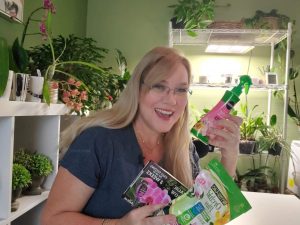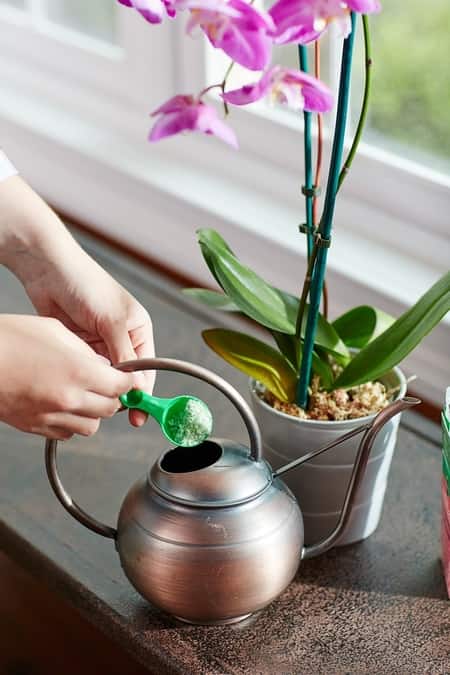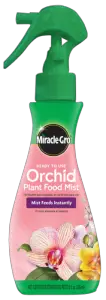More often than not, there will be leftover orchid fertilizer when you’re done watering. If you have other household plants, it’s a temptation to just water them with that same fertilized water.With prices that are skyrocketing these days for orchid fertilizer, there’s no reason to be wasting it. Since orchids are “light” feeders, not much fertilizer is necessary. As long as it’s in an extremely weak dose and applied constantly, your orchid will do fine.
Are there any side effects of using orchid fertilizer for other household plants?
You can apply the orchid fertilizer without harm to other household plants, as long as you aren’t applying it to a vegetable garden or produce that you’ll be consuming later on. Most household plants will require a lower dose of fertilizer, not the higher concentration of the solution necessary for orchids.

Each plant has a specific requirement for nutrients, and some fertilizers can harm household plants if used in excess.
In this article, you’ll read about what is in orchid fertilizer, what it does to the orchid, and the side effects of orchid fertilizer applied to household plants.
What is in orchid fertilizer?
The N-P-K ratio is how nitrogen, phosphorus, and potassium are mixed together to form that specific fertilization formula. When you buy a balanced orchid fertilizer, those numbers will be equal in proportion, for example, 10-10-10 signifies that there are equal parts of all three elements.
30-10-20 means there is 30 % Nitrogen, 10% Phosphorus, and 20% Potassium.
The problem is that in orchid fertilizers, not only nitrogen, phosphorus, and potassium are added into the solution. There are usually other chemicals and nutrients that aid the orchid growth.
Some fertilizers are marketed to specific plants, yet the fertilizer inside the bottle is composed of the exact same chemicals, only with a label and price change. This is why it’s important to check out the label and see what is added to the solution.
How does nitrogen in orchid fertilizer help other household plants?
Nitrogen will help the orchid in leaf development.
This is the first number in the ratio and can be found with the titles of nitrate or ammoniacal nitrogen.
Either is fine.

Nitrogen is usually applied with the strongest solution after root development since it focuses on strong leaf development. On the other hand, Nitrogen does nothing for the roots. Nitrogen is found in the air we breathe, and since orchids are epiphytes, attaching themselves to trees and not in potted soil, they have a higher demand for Nitrogen.
Household plants will benefit from the high nitrogen count since Nitrogen is also fundamental for the production of chlorophyll. The chlorophyll aids in producing energy from the light it receives, this is why it is important in strong leaf production. Strong foliage is necessary for any plant since they photosynthesize.
Orchid enthusiasts stay away from urea nitrogen. Yet in other plants, urea nitrogen is beneficial. It won’t hurt to have a fertilizer that doesn’t fulfill that requirement, but if this is the only fertilizer that your indoor flower is receiving, then I’d keep an eye on your plants. You might need a bit more to have strong healthy plants.
Tip: If you are planning on using the orchid fertilizer as an additional fertilizer for tomatoes or vegetables, I wouldn’t recommend it. Even household plant fertilizers aren’t recommended. They have specific needs that an orchid fertilizer can’t supply.
Will the Phosphorus in orchid fertilizer help household plants?
Phosphorus, the 2nd ingredient in the NPK ratio, will help the orchid in the blossoming period. It focuses on strong roots, seeds, and flower spikes, all to have healthy flowers. The beauty of the flower is in a strong, healthy blossom, not the color or shape.
This is a mistake that a lot of us commit when buying orchids: we look at the blossom only, ignoring the pseudobulbs, leaves, and roots. The orchid flower can be beautiful, but if the plant is not healthy, it will die soon—independent of beautiful blossoms.
This is where the phosphorus comes in.
The problem with the Phosphorus in orchid fertilizer is that the recommended dose for household plants is quite low. Phosphorus is the 2nd number in the N-P-K ration, and in household plants is rarely over the proportion of 5.
Most common household fertilizers use the ratios:
1-3-1,
or 5-3-3,
or even 5-5-5.
Orchid fertilizers are more towards 30-10-10- or 20-20-20 or 30-10-10. As you can see, the ratios are way higher than the average household plant could withstand.
The additional problem is that if you are using leftover orchid water to add to your other plants, you’ll be adding this concentration weekly. The result: too much orchid fertilizer and applied too often will harm your household plants.
Will the Potassium in orchid fertilizer help other plants?
Potassium will maintain the orchid’s health, fighting off diseases and preventing infections. It is considered the orchid’s natural line of defense, aiding in overall well-being.
Just like humans have an immune system, the orchid uses potassium to build up a strong “immune system” against natural pests and bacteria. Resistance against heat, cold, drought, and also over-watering is built up using potassium.

Potassium is also an important regulator for the opening and closing of the stomata, which controls the gas exchange in the leaves. Without potassium, a natural exchange is hindered, and your orchid starts to wilt.
Since the potassium is an important part of the leaf, where the pores (or stomata) are located, one of the first signs of potassium deficiency is the yellow tips of the leaves.
What other elements are added to Orchid Fertilizer?
In essence, only these three. That is why it is important to add fertilizer supplements. In this article, I explain the benefits of using crushed eggshells for extra calcium and the benefits of that. There are many other fertilizer supplements that you should be adding to your orchid, like magnesium. Many orchid fertilizers sold on the market have none of those.
So when these are added into the household plants, they will come in lacking for other nutrients that household plants need, like iron, zinc, magnesium, calcium, and boron.
Does it matter what method of fertilizing I use?
The most common way o to fertilize is by diluting in water. This solution is then applied after the first watering in the morning.
That is not the only method to fertilize. In this article, I explain the five types of fertilizer and how each one is used. It’s worth a read if you’re into testing different ways of using fertilizer, or if you want an idea of what fertilizer to use.
Don’t Stop Learning!
If you want to be included in more information and get a 14-page fertilization guide, please sign up for my newsletter. I don’t spam, but send emails out bi-monthly with some curious topics of interest. If you want more information, click here to go to a specific page on this website where I explain it more in detail.

Also, if you are looking for an orchid journal to keep your notes specifically about orchid care, check out my 2 solutions for that on this page. If note-keeping isn’t your thing, then there is a free excel spreadsheet that you can download. Click here for more information on how to do that.
If you subscribe to my newsletter, I will send you a 14-page guide on the main tips of orchid fertilizer. It is downloadable and you can print it out on your computer. I designed the guide to double up as a coloring book, just to make it fun.
What’s the worst thing that could happen if I use orchid fertilizer on household plants?
The main concern is over-fertilizing the household plant. Since orchids need to be fertilized on a weekly basis, this can be too much for the average household plant.
Even though the concentration is minute, it still is more than a household plant would require. Besides, most fertilizers are applied every week; fertilization in every single dose.
Most household plants need fertilizing only once every two or three months.
This overload of chemicals in the soil will make the leaves weak. It will also make your plant more susceptible to infections and disease. Yet, we still tend to over-fertilize way too much. The quote by Mae West explains this well. “If a little is great, and a lot is better, then way too much is just about right!”
The surface of the plant-soil will become crusty and appear to have crystallized powder on it. The leaves will turn yellow, then brown, and eventually fall off. Your household plant will slowly die off, and growth will be hindered. All these are direct effects of over-fertilizing.
What plants react the best with Orchid Fertilizer?
If you have African Violets, these are the best household plants that will benefit from orchid fertilizer. African violets grow in some of the same conditions that Phalaenopsis do, and have similar tastes in nutrient requirements.
Succulents of any kind will also react well to orchid fertilizer. Since they also have a light watering schedule, very similar to many most common orchids (excluding the thigh humidity ones, which thrive on humid potting medium), succulents benefit from the leftover water used for orchids.
Further Reading Suggestions:
Don’t just take my word for what is written here. Continue researching other articles about orchid fertilizer on other plants, because everyone has a different point of view and unique techniques that work for them. Here are a few other articles from other websites if you’d like to continue your research on orchid fertilizer for household plants:
-“Growing Orchids ” written by Barbara Larson, published on University of Illinois Extension Website talks abouthow to cultivate orchids, and has a brief paragraph about fertilizing orchids.
” written by Barbara Larson, published on University of Illinois Extension Website talks abouthow to cultivate orchids, and has a brief paragraph about fertilizing orchids.
-“Orchid Care for the Novice- An Orchid’s Perspective” written by Kent Kobashi, published on Tropical Plant & Soil Sciences Dept., College of Tropical Agriculture & Human Resources, University of Hawaii at ManoaWebsite states that, “Most orchid potting media provide only support and have little or no food value. The plant food you use depends on the type of orchid and the type of growing media. It need to be fertilized with a product suitable for the media. When the plants are in bark, they need a high nitrogen food (such as 30-10-10). Plants in most other media need a balanced food (such as 18-18-18). You can also use a water-soluble fertilizer at the dilution recommended on the label.”
-“Orchids as Houseplants “ written by S. Schouten, published on Horticulture and Home Pest News, and Iowa State University Extension and Outreach Website states that, “Orchids planted in orchid potting mixes or fir bark need to be fertilized while those in osmunda fiber need very little fertilization. For those that need it, a light feeding of 30-10-10 (1/4 tsp. per gallon) or 15-5-5 (1/2 tsp. per gallon) each time the plants are watered is beneficial. Substituting the use of fish emulsion for fertilizer every other watering will also benefit your orchids. Reduce the use of high nitrogen fertilizers during the winter months when plants are resting.“
“ written by S. Schouten, published on Horticulture and Home Pest News, and Iowa State University Extension and Outreach Website states that, “Orchids planted in orchid potting mixes or fir bark need to be fertilized while those in osmunda fiber need very little fertilization. For those that need it, a light feeding of 30-10-10 (1/4 tsp. per gallon) or 15-5-5 (1/2 tsp. per gallon) each time the plants are watered is beneficial. Substituting the use of fish emulsion for fertilizer every other watering will also benefit your orchids. Reduce the use of high nitrogen fertilizers during the winter months when plants are resting.“
In a nutshell, you can use orchid fertilizer to water your household plants, but stay far away from the vegetable garden and don’t use the same water every week. If it’s a one-time thing, go for it. No use in wasting water. 😊
Happy Cultivating.


I have a question. Do I need to completely change the fertilize water that my orchids have been for 5 days? My orchids are growing in water culture.
HI Oralia,
Thank you for your comment. I appreciate it. 🙂
There are a few kinds of water culture methods and each one is a bit different when it comes to fertilizing. In this article, https://orchideria.com/fertilize-orchids-in-water-culture/ you can check out which method you are using and fertilize accordingly. No matter which method you use, make sure that it’s an extremely tiny dose. I tend to overfertilize and the entire orchid turns yellow.
-Amanda
“”30-10-20 means there is 30 % Nitrogen, 20% Phosphorous, and 10% Potassium.””
This sentence in your opening paragraph opens the question if it is worth reading any further ??? “Explaining” 30-10-20 as if it were 30-20-10 Can I trust the remaining information or is that riddled with basic mistakes as well?????
Hi Ben,
Thank you so much for pointing out that mistake, as I switched the numbers and didn’t realize it. I honestly don’t know how I didn’t catch that in editing. I’ll change it right now.
You are absolutely right about seeing a mistake in someone’s article, I would doubt the credibility of the article. Yet, I also could see it as a typo and not think too much of it. I’d have to read the other articles on that website to get a full overview of how much I could rely on that information.
As I have done in the past, if the mistake really bothered me (most wouldn’t), I would write the author and state something like “Please check your numbers,” or ” Are you sure that there isn’t a mistake in the NPK ratio?”. I sure wouldn’t come across as harsh as you did in your reply. After all, I’m only human. You’re replying to a real person and not a computer-generated article that has no feelings. That is why I took your comment as a bit over the top.
Can you trust the remaining information? I can’t tell you what to trust. Just so you know, yes, I research these articles and it takes tons of hours reading several different authors and viewpoints. I combine them all into an article that tries to be fair to each side yet maintain what I believe, too. So each article on this website has taken tons of hours to write. So take what you’d like and leave the rest that doesn’t apply.
So in all, I appreciate your comment because I can correct my typo but wish there were much less negative sentiment to it.
-Amanda